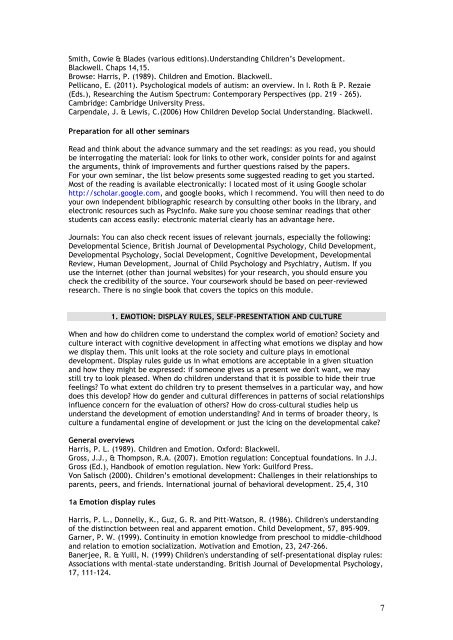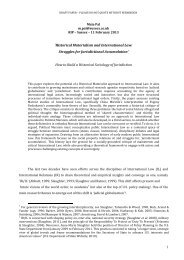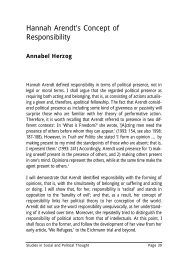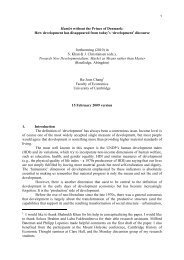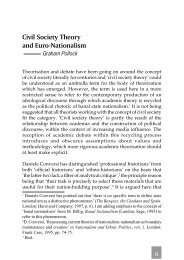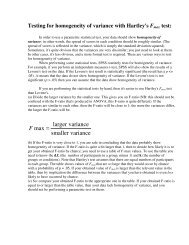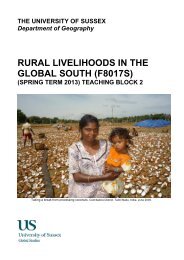Social Cognitive Development handbook 13-14 - University of Sussex
Social Cognitive Development handbook 13-14 - University of Sussex
Social Cognitive Development handbook 13-14 - University of Sussex
You also want an ePaper? Increase the reach of your titles
YUMPU automatically turns print PDFs into web optimized ePapers that Google loves.
Smith, Cowie & Blades (various editions).Understanding Children’s <strong>Development</strong>.<br />
Blackwell. Chaps <strong>14</strong>,15.<br />
Browse: Harris, P. (1989). Children and Emotion. Blackwell.<br />
Pellicano, E. (2011). Psychological models <strong>of</strong> autism: an overview. In I. Roth & P. Rezaie<br />
(Eds.), Researching the Autism Spectrum: Contemporary Perspectives (pp. 219 - 265).<br />
Cambridge: Cambridge <strong>University</strong> Press.<br />
Carpendale, J. & Lewis, C.(2006) How Children Develop <strong>Social</strong> Understanding. Blackwell.<br />
Preparation for all other seminars<br />
Read and think about the advance summary and the set readings: as you read, you should<br />
be interrogating the material: look for links to other work, consider points for and against<br />
the arguments, think <strong>of</strong> improvements and further questions raised by the papers.<br />
For your own seminar, the list below presents some suggested reading to get you started.<br />
Most <strong>of</strong> the reading is available electronically: I located most <strong>of</strong> it using Google scholar<br />
http://scholar.google.com, and google books, which I recommend. You will then need to do<br />
your own independent bibliographic research by consulting other books in the library, and<br />
electronic resources such as PsycInfo. Make sure you choose seminar readings that other<br />
students can access easily: electronic material clearly has an advantage here.<br />
Journals: You can also check recent issues <strong>of</strong> relevant journals, especially the following:<br />
<strong>Development</strong>al Science, British Journal <strong>of</strong> <strong>Development</strong>al Psychology, Child <strong>Development</strong>,<br />
<strong>Development</strong>al Psychology, <strong>Social</strong> <strong>Development</strong>, <strong>Cognitive</strong> <strong>Development</strong>, <strong>Development</strong>al<br />
Review, Human <strong>Development</strong>, Journal <strong>of</strong> Child Psychology and Psychiatry, Autism. If you<br />
use the internet (other than journal websites) for your research, you should ensure you<br />
check the credibility <strong>of</strong> the source. Your coursework should be based on peer-reviewed<br />
research. There is no single book that covers the topics on this module.<br />
1. EMOTION: DISPLAY RULES, SELF-PRESENTATION AND CULTURE<br />
When and how do children come to understand the complex world <strong>of</strong> emotion? Society and<br />
culture interact with cognitive development in affecting what emotions we display and how<br />
we display them. This unit looks at the role society and culture plays in emotional<br />
development. Display rules guide us in what emotions are acceptable in a given situation<br />
and how they might be expressed: if someone gives us a present we don't want, we may<br />
still try to look pleased. When do children understand that it is possible to hide their true<br />
feelings? To what extent do children try to present themselves in a particular way, and how<br />
does this develop? How do gender and cultural differences in patterns <strong>of</strong> social relationships<br />
influence concern for the evaluation <strong>of</strong> others? How do cross-cultural studies help us<br />
understand the development <strong>of</strong> emotion understanding? And in terms <strong>of</strong> broader theory, is<br />
culture a fundamental engine <strong>of</strong> development or just the icing on the developmental cake?<br />
General overviews<br />
Harris, P. L. (1989). Children and Emotion. Oxford: Blackwell.<br />
Gross, J.J., & Thompson, R.A. (2007). Emotion regulation: Conceptual foundations. In J.J.<br />
Gross (Ed.), Handbook <strong>of</strong> emotion regulation. New York: Guilford Press.<br />
Von Salisch (2000). Children’s emotional development: Challenges in their relationships to<br />
parents, peers, and friends. International journal <strong>of</strong> behavioral development. 25,4, 310<br />
1a Emotion display rules<br />
Harris, P. L., Donnelly, K., Guz, G. R. and Pitt-Watson, R. (1986). Children's understanding<br />
<strong>of</strong> the distinction between real and apparent emotion. Child <strong>Development</strong>, 57, 895-909.<br />
Garner, P. W. (1999). Continuity in emotion knowledge from preschool to middle-childhood<br />
and relation to emotion socialization. Motivation and Emotion, 23, 247-266.<br />
Banerjee, R. & Yuill, N. (1999) Children's understanding <strong>of</strong> self-presentational display rules:<br />
Associations with mental-state understanding. British Journal <strong>of</strong> <strong>Development</strong>al Psychology,<br />
17, 111-124.<br />
7


